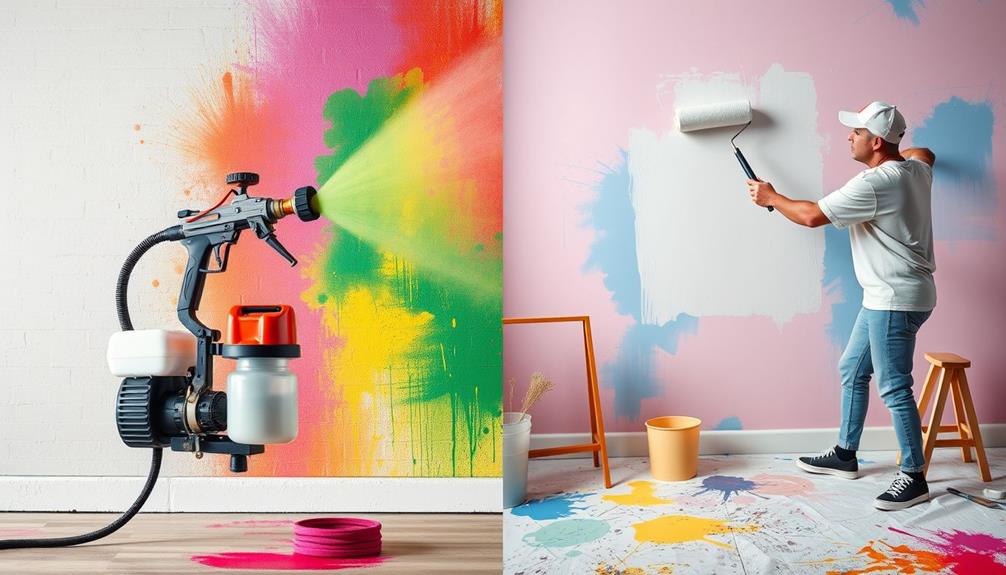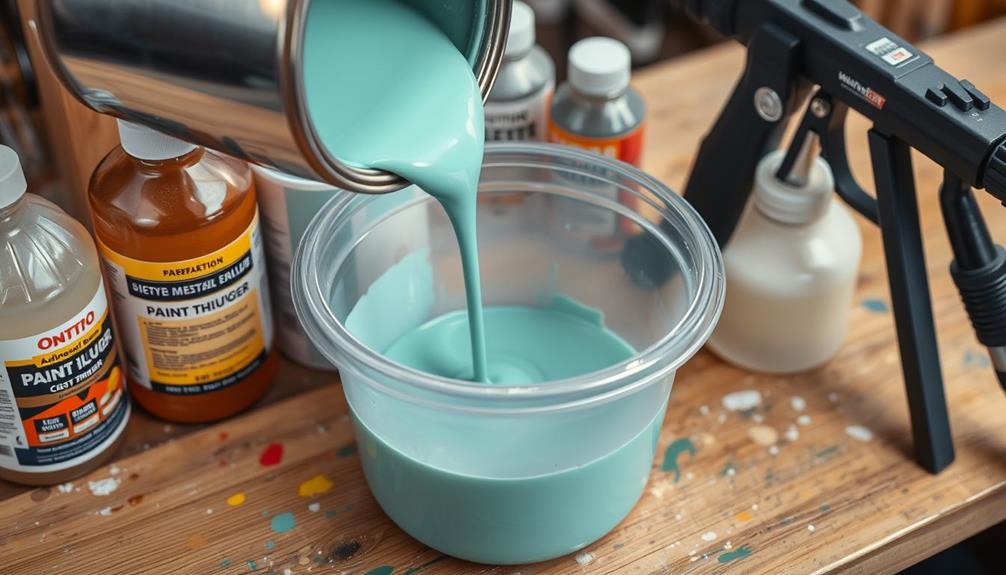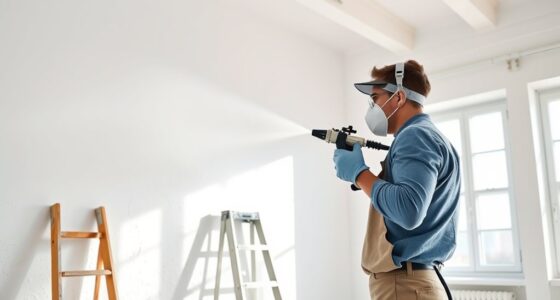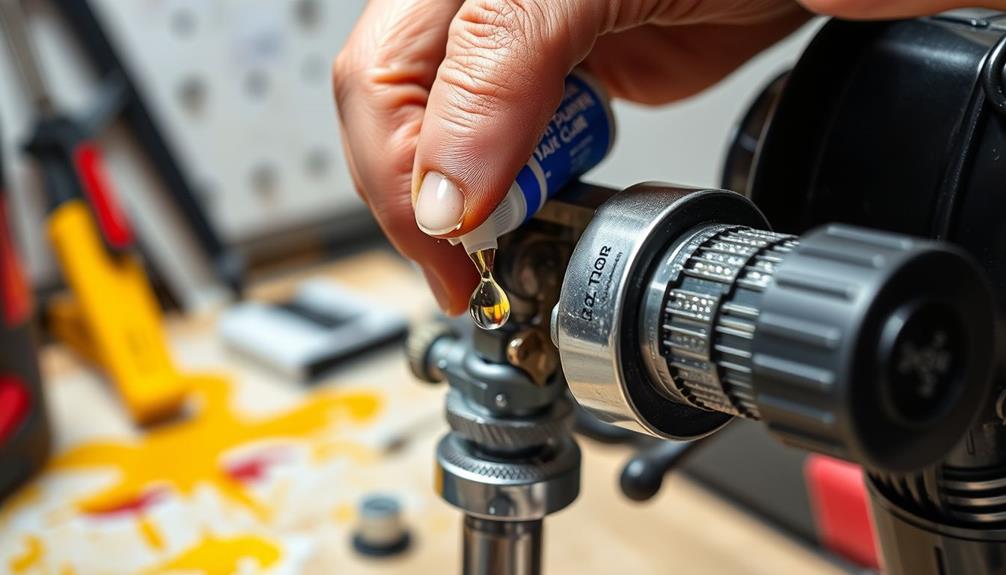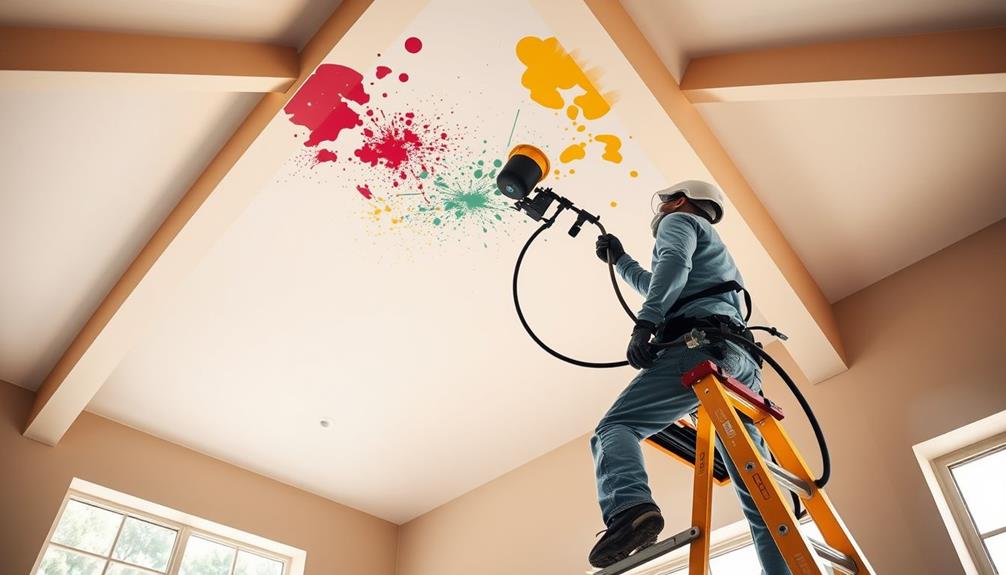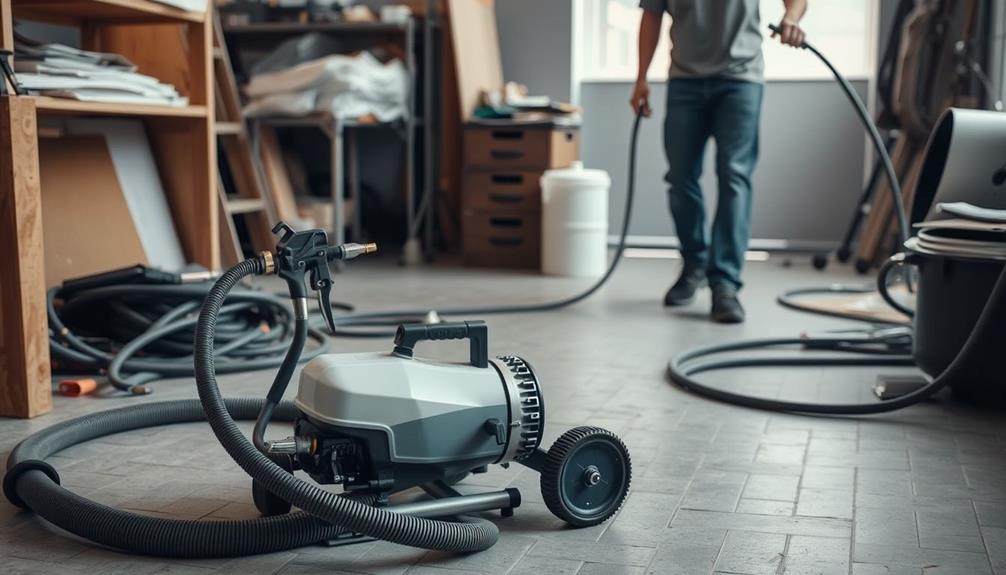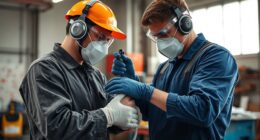When it comes to speed, airless paint sprayers usually outpace rollers, especially for larger projects. They cover vast areas quickly and deliver a smooth finish, making them ideal for open spaces. However, don't overlook the prep and cleanup time; sprayers require extensive masking and thorough cleaning, which can offset some of that speed. On the other hand, rollers are easier to use, letting you pause easily without wasting paint. If you want to know more about the specific pros and cons of each method, keep going to discover the best fit for your painting needs.
Key Takeaways
- Airless paint sprayers cover large areas faster than rollers, making them ideal for expansive spaces and large projects.
- Sprayers provide a smoother finish, enhancing professional results but may require additional touch-ups due to streaking.
- Rollers allow for easier pauses and can be started immediately with less prep, making them efficient for smaller jobs.
- Although sprayers save time in application, longer prep and cleanup times can offset this advantage.
- Overall, sprayers are faster for big projects, while rollers excel in controlled, smaller applications.
Overview of Painting Methods
When you're deciding how to tackle a painting project, it's essential to understand the two main methods: airless paint sprayers and rollers. Each has its advantages and is suited for different tasks. An airless paint sprayer can cover large areas considerably faster than a roller, making it ideal for expansive spaces or complex textures.
For example, painting a 900 sq. ft. loft with a sprayer might only take two long days, while using a roller could stretch that project to several days. Additionally, airless sprayers provide a more even finish, which is beneficial for achieving professional results on surfaces like walls and ceilings to learn more about sprayer benefits.
However, don't overlook the overall project time. While spraying reduces the application time, it often increases prep and cleanup time. You might find that the total duration of using a sprayer could end up being similar to rolling methods.
Additionally, there's a learning curve with sprayers that could impact your initial speed. If you're new to painting, rolling might be the more intuitive choice, allowing for quicker starts.
Ultimately, the best painting method depends on your specific project needs, space, and comfort level with the tools at hand. Consider these factors carefully as you plan your next painting endeavor.
Speed Comparison
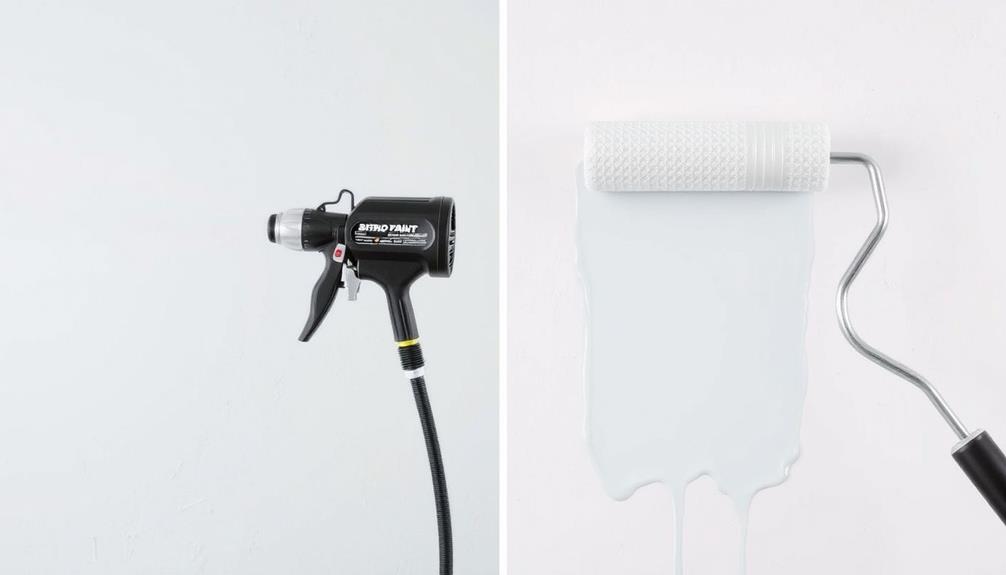
When it comes to speed, airless paint sprayers outpace rollers by covering large areas much faster. These sprayers can also deliver a smoother finish, which can save time in the overall process.
While you'll need to invest time in prep and cleanup, the overall application time is greatly reduced, making sprayers ideal for big projects. Plus, you'll find that touch-ups are quicker with a sprayer, allowing you to finish your job efficiently.
Additionally, utilizing modern tools can enhance your work efficiency in various home improvement tasks, such as garage door openers.
Application Time Efficiency
Choosing between an airless paint sprayer and a roller often boils down to application time efficiency. Paint sprayers excel in covering large areas quickly, letting you finish entire rooms in just a couple of days. In contrast, rolling paint can take several days, especially for bigger projects. Here's a quick comparison to illustrate the differences:
| Method | Application Time Efficiency |
|---|---|
| Airless Paint Sprayer | Fast for large areas, multiple coats dry quickly |
| Roller | Slower, but easier to pause and resume in small spaces |
While spraying is faster, keep in mind that the extensive prep work can offset those time savings. You might find that overall project times can be similar to rolling in some cases. Plus, for large, flat surfaces, paint sprayers allow quick drying between layers. However, rollers offer a more straightforward cleanup process, which can enhance overall efficiency. Ultimately, consider your project size and specific needs when deciding which method best suits your application time efficiency goals.
Prep and Cleanup Duration
Typically, the prep and cleanup time for an airless paint sprayer can be considerably longer than that for a roller. When you're getting ready to use a sprayer, you'll need extensive masking and taping to prevent overspray, which adds significant time to your prep work. This is similar to the care needed for gas appliances during power outages, where proper precautions must be taken to guarantee safety.
In contrast, rolling requires much less initial setup, allowing you to dive right into your painting project.
Once you've finished, the cleanup process with an airless sprayer is also more complex. You'll need to thoroughly clean the spray gun, hoses, and any other equipment, which can take a lot longer than just rinsing out a roller and tray.
Although airless sprayers can cover large areas quickly once they're set up, the time saved in application may be offset by the longer prep and cleanup times.
For smaller projects, you might find that the overall time is similar whether you choose a sprayer or a roller. It's important to weigh the initial time savings against the additional time required for setup and cleanup to determine which method best fits your needs.
Touch-Up Needs Comparison
The speed of touch-ups can vary greatly between airless paint sprayers and rollers. While sprayers can cover large areas quickly, allowing for multiple coats in a single day, they often lead to more touch-up needs due to potential streaking and overspray. This means that despite the initial speed advantage, you might find yourself spending extra time fixing those imperfections later on.
Additionally, achieving a smooth finish is vital for creating a serene atmosphere in your home, similar to the calming effects of a modern farmhouse bedroom which emphasizes tranquility.
On the other hand, rollers may take longer to set up and apply, but they offer better control over paint thickness. This control can greatly reduce the likelihood of uneven patches, meaning fewer touch-ups in the long run.
Rollers can be paused easily without wasting paint, making them a practical option for smaller touch-up jobs where precision is key.
Surface Preparation Techniques
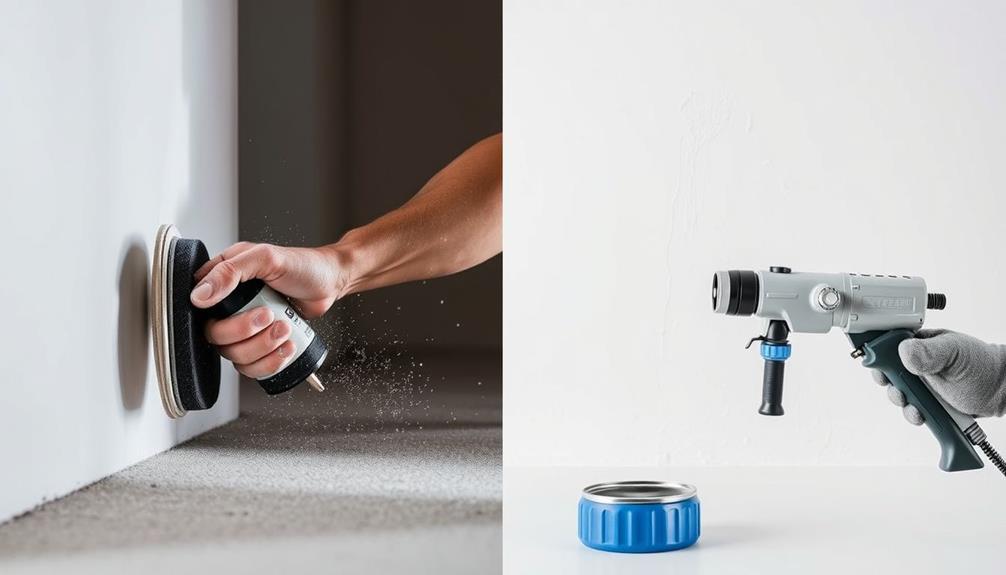
When you're preparing a surface for painting, you need to focus on cleaning and priming to guarantee the best adhesion, especially with an airless sprayer.
It's essential to recognize that maintaining a clean indoor environment can greatly improve the overall air quality while you work, making it more comfortable and healthy reduce allergens.
Sanding rough areas helps the paint stick better, while masking with painter's tape protects edges and keeps your work neat.
Don't forget to take into account environmental factors like humidity and temperature, as they play a vital role in the paint's performance.
Cleaning and Priming Surfaces
Successful paint application hinges on meticulous surface preparation, which includes thorough cleaning and priming.
Whether you're using an airless paint sprayer or a roller, proper cleaning is essential to guarantee ideal adhesion. For airless sprayers, you'll want to meticulously clean rough surfaces, as this enhances paint adhesion and allows for a smooth application.
If the surface is porous or uneven, applying primer is a crucial step; it not only improves the overall finish but also increases durability. Additionally, making sure that your cleaning supplies, such as microfiber cloths and multi-surface cleaners, are at hand can streamline the preparation process, akin to the essential items in a home cleaning kit.
While rollers usually require less stringent preparation, you shouldn't overlook cleaning. Masking with painter's tape remains important to protect adjacent surfaces and achieve crisp lines.
Keep in mind that environmental conditions, like humidity and temperature, can greatly influence paint adhesion. Before you begin, it's wise to check these factors to avoid potential issues.
Sanding for Adhesion
Sanding plays an indispensable role in preparing surfaces for painting, as it enhances adhesion and guarantees a long-lasting finish. When you sand surfaces, you create a rough texture that helps the paint grip better, resulting in a more durable outcome.
For ideal results, it's best to use medium-grit sandpaper, around 120-150 grit, especially on rough surfaces before applying primer or paint. Additionally, verifying that the surface is free of contaminants will improve the overall quality of your finish, especially when using techniques like proper dilution of paint for airless sprayers.
If you're working with previously painted surfaces, sanding is vital. It helps remove any gloss, allowing the new paint to adhere more effectively and reducing the risk of peeling down the line.
However, don't forget to clean up the dust created during sanding. Use a damp cloth or vacuum to confirm the surface is free of contaminants before applying paint.
Proper surface preparation, including effective sanding, can greatly reduce the need for additional coats of paint. This not only saves you time but also cuts down on material costs, making your painting project more efficient.
Masking for Protection
After guaranteeing your surface is properly sanded and free of contaminants, it's time to focus on masking for protection.
Proper masking is vital when using an airless paint sprayer, as it prevents overspray from damaging adjacent surfaces. For best results, consider using well-draining soil techniques to maintain a clean work area.
Here's what you need to do:
- Use high-quality painter's tape for clean lines and to avoid paint bleed.
- Apply the tape at a 45-degree angle to enhance adhesion and achieve sharper edges.
- Cover furniture and floors with drop cloths or plastic sheeting to catch any overspray.
- Check your masking job for gaps or areas needing extra tape before spraying.
- Remove the tape while the paint is still slightly wet to guarantee smooth edges.
Cost Analysis
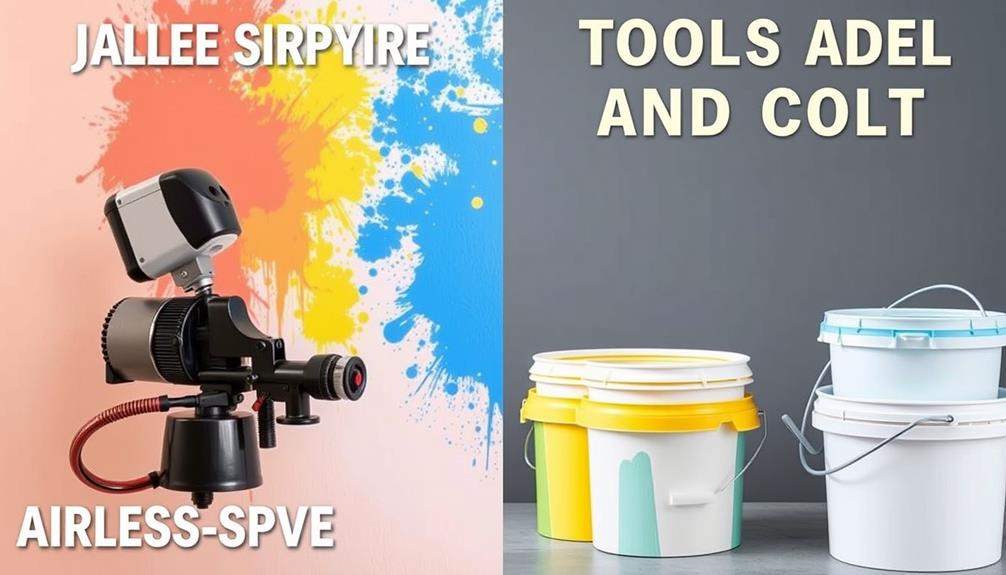
Considering your budget, understanding the cost implications of airless paint sprayers versus rollers is essential. Airless paint sprayers start at around $300, making them a significant initial investment. In contrast, rollers require minimal supplies, costing under $50, which makes them more accessible for DIY enthusiasts.
If you're looking to rent an airless sprayer, be prepared to spend between $40 and $100 per day, adding to your overall expense for short-term projects. Additionally, using tools that are budget-friendly vacuum cleaners can help you maintain a clean workspace, which is vital when painting.
Another important factor in this cost analysis is how much paint each method uses. Sprayers typically consume about 33% more paint due to overspray, which can inflate your material costs, especially on large jobs. In the long run, rollers tend to have lower ongoing expenses, thanks to reduced paint waste and fewer tool replacements compared to airless sprayers.
While airless paint sprayers might save you time, their higher upfront and material costs can make rollers a more budget-friendly choice for many projects. Ultimately, weighing the costs against your specific needs will help you decide which option is best suited to your financial situation.
Finish Quality

When it comes to finish quality, airless paint sprayers often shine, delivering a smoother and more uniform application than rollers. If you're aiming for a high-gloss surface without lap marks, sprayers are your go-to option.
Rollers can leave a slight texture, especially with certain nap sizes, which may not meet your desired finish quality. Additionally, employing techniques that promote relaxation and focus, such as practicing meditation, can help you maintain precision during painting, leading to better results.
Here are some key points to take into account:
- Sprayers excel in intricate designs and hard-to-reach areas.
- They provide a finish that can greatly enhance the overall aesthetic of your project.
- Achieving a smoother finish requires careful technique, particularly with darker colors to avoid streaking.
- The type of paint you choose can also impact the finish; some paints don't perform well with sprayers, making rollers a better choice in those cases.
- Overall, while both methods have their merits, sprayers typically offer a more polished result for professional-looking outcomes.
User Experience and Learning Curve
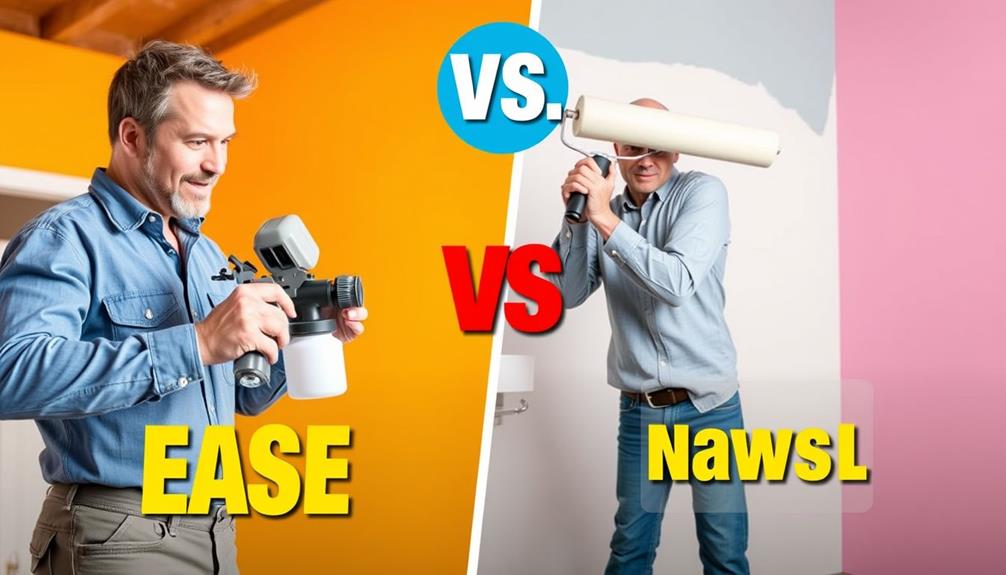
Using an airless paint sprayer can feel like stepping into a whole new world of painting for many beginners. The user experience with a sprayer often involves a considerable learning curve. You'll need to master the right distance and spray intensity to avoid drips and uneven application. If you're inexperienced, you might find yourself struggling with streaking, especially when working with darker colors.
On the other hand, rolling paint is more intuitive and easier for most newbies. It allows for better control over your application without the steep learning curve associated with sprayers. While rollers can be simpler to use initially, they mightn't yield the smooth finishes that proficient sprayer users achieve.
As you gain experience, mastering spray techniques can lead to faster application times and superior results. However, if you're just starting, you may find rollers to be more manageable.
Ultimately, your experience level will considerably impact the effectiveness of either method, making it essential to reflect on where you're at in your painting journey before diving into the world of airless paint sprayers.
Ideal Use Cases
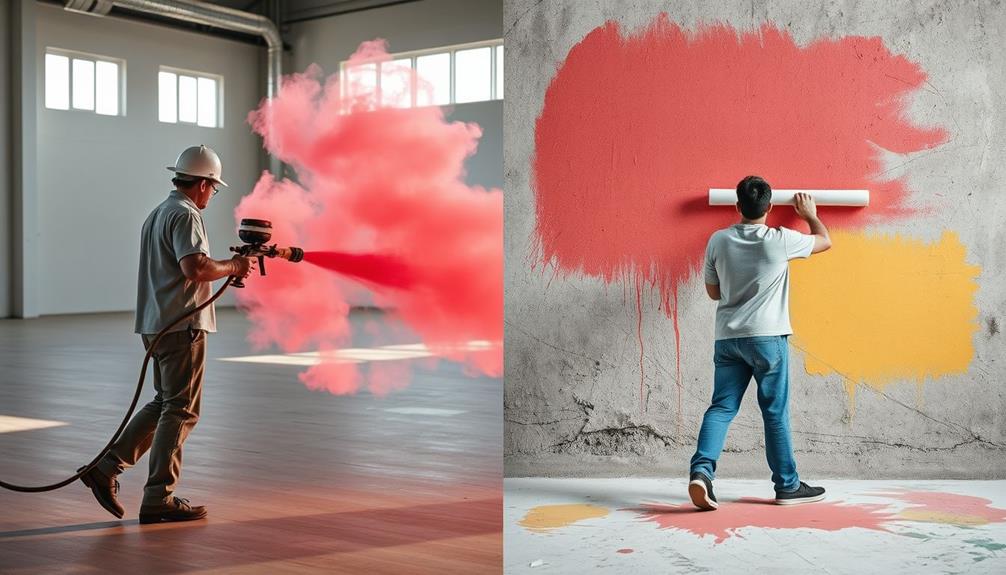
For those tackling larger painting projects, airless paint sprayers shine in their ability to cover vast areas quickly and efficiently. When you have an expansive space, like an exterior wall or an empty interior, a sprayer can greatly reduce your project time.
Here are some ideal use cases for each method:
- Large exteriors: Sprayers handle expansive surfaces effortlessly.
- Intricate textures: Airless sprayers excel at tackling detailed areas and hard-to-reach spots.
- Open interiors: If you're painting a big, empty room, a sprayer will save you hours.
- Occupied spaces: Rollers are better for occupied interiors since they require less prep and allow for quick pauses.
- Thicker paint applications: Rollers may take longer but often need fewer coats on flat surfaces.
While sprayers are fantastic for speed, remember that their initial setup and cleanup can offset those benefits.
In some cases, your overall project time might end up similar to using rollers. Ultimately, choosing between a sprayer and rollers depends on the specifics of your project and the space you're working in.
Frequently Asked Questions
Is a Paint Sprayer Faster Than a Roller?
Yes, a paint sprayer's often faster than a roller, letting you cover large areas quickly. However, don't forget about the prep work needed; that can balance out the speed advantage when you're painting.
How Much Faster Is Using a Paint Sprayer?
Using a paint sprayer can save you significant time, often completing large areas in just two days. While it's quicker for application, don't forget to factor in the prep and cleanup involved.
What Are the Disadvantages of an Airless Paint Sprayer?
You'll love the overspray that dances around, wasting paint. Sure, it's costly, but who doesn't enjoy a good cleanup? And don't worry about mastering the technique—it's fun to embrace those drips and uneven coverage!
How Fast Is Airless Paint Sprayer?
An airless paint sprayer can cover up to 300 square feet per hour, letting you finish large areas quickly. Though setup takes time, the actual painting process is considerably faster than traditional methods.
Conclusion
In the battle of airless paint sprayers versus rollers, speed takes center stage. While sprayers can coat large areas in a flash, rollers offer precision in tight spots. Imagine the sprayer dancing across a wall, leaving a smooth finish, while the roller methodically fills in corners. Each method has its place: sprayers for efficiency and rollers for detail. Ultimately, your choice hinges on the job at hand, merging speed with quality for the perfect paint project.
